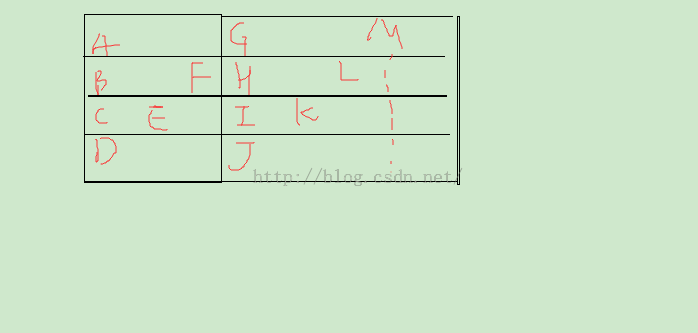LeetCode OJ : 6 ZigZag Conversion
The string "PAYPALISHIRING" is written in a zigzag pattern on a given number of rows like this: (you may want to display this pattern in a fixed font for better legibility)
P A H N A P L S I I G Y I RAnd then read line by line:
"PAHNAPLSIIGYIR"
Write the code that will take a string and make this conversion given a number of rows:
string convert(string text, int nRows);
convert("PAYPALISHIRING", 3) should return "PAHNAPLSIIGYIR".
这个例子分为了三行,所以需要三个string对象来保存每一行的字符串,最后按顺序(从第一排到最后一排)将字符串相加起来;这个求和之后的字符串就是所求,将它返回;
把变换之后的看成是一个周期变化的,第一个周期 P-A-Y-P,第二个周期A-L-I-S,第三个周期....
每个周期又有规律可循,P-A-Y分别存放在0-1-2行;接下来的p存放在1行;然后又是下一个周期。。。。
比如是四排的时候;
第一个周期A-B-C-D-E-F;首先将A-B-C-D存放在0-1-2-3排,再将E-F存放在2-1排。。所以存放在不同排的顺序应该是0-1-2-3-2-1;
所以A-B-C-D-E-F对应存放在0-1-2-3-2-1;
每2 * numRows-2个字符依次存放在0-1-2-....-(numRows-1)-(numRows-2)-......--1;
class Solution {
public:
string convert(string s, int numRows) {
vector<string> vstr(numRows);
int i = 0, j = 0;
if(s.size() == 0){
return s;
}
for (i = 0; i < s.size(); ){
for (j = 0; j < numRows; ++j){
if(i == s.size()){
break;
}
vstr[j].push_back(s[i++]);
}
for (j = numRows-2; j >=1 ; --j){
if(i == s.size()){
break;
}
vstr[j].push_back(s[i++]);
}
if(i == s.size()){
string str;
for (i = 0; i < numRows; ++i){
str += vstr[i];
}
return str;
}
}
}
};

运行效率比较低,不过这个运行时间不稳定,第一次提交的时候是22/%。。
